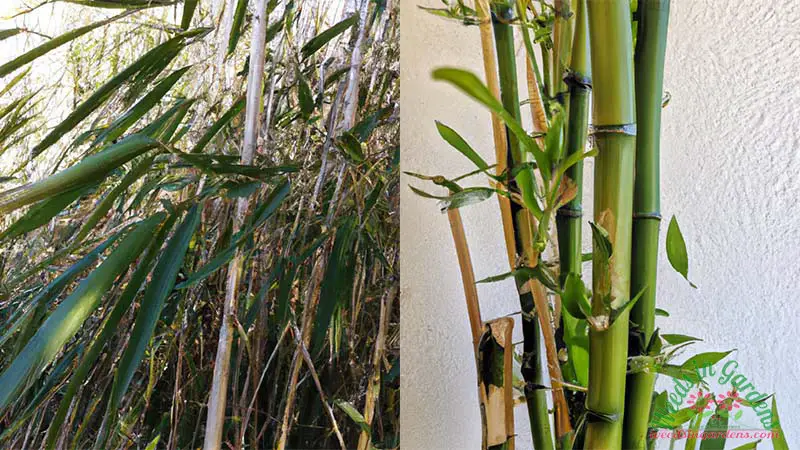Bamboo plants have been used in landscaping and gardening for a long time because they look nice and grow quickly. They are becoming more and more popular as a way to decorate gardens, landscapes, and even rooms. However, the common perception of bamboo plants as invasive has also been gaining ground. Many people are concerned about the spread of these plants, which can quickly grow out of control and cause problems for surrounding plants, trees, and other vegetation. But not all bamboo plants are invasive, and it’s important to understand the differences between invasive and non-invasive species to make informed decisions when planting.

This article aims to give a complete picture of how invasive bamboo plants are and clarify that not all bamboo species are invasive. By knowing the differences between invasive and non-invasive bamboo species, gardeners and landscapers can plant bamboo in their gardens and landscapes with confidence.
Invasiveness of Bamboo Plant
An invasive species is defined as a plant or animal that is not native to a specific area and has the potential to cause harm to the environment, economy, or human health. Some examples of invasive plant species include kudzu, Japanese knotweed, and purple loosestrife. These species are known for their ability to spread quickly and take over large areas, leading to negative impacts on local ecosystems.
Whether or not a bamboo plant is invasive depends on a number of things, such as how it grows, how easily it can reproduce, and the environment around it. All bamboo plant types are not invasive. Running bamboo, for example, is often seen as more invasive because its underground rhizomes can spread quickly and choke out other plants.
If invasive bamboo plants are allowed to grow without being stopped, they can greatly affect the ecosystem. They can alter natural habitats, displace native species, and even cause soil erosion. So, it’s important to know how invasive bamboo plants are so you can make an informed decision about whether or not to plant them in your own yard or garden.
Types of Bamboo Plants
Bamboo plants belong to the grass family and come in a variety of species and sizes, ranging from small, ground-hugging plants to tall, towering giants.
There are two main types of bamboo plants: clumping bamboo and running bamboo. Clumping bamboo grows in tight clusters and spreads slowly, while running bamboo spreads rapidly through underground rhizomes.
Clumping bamboo plants are known for their attractive, non-invasive growth habit, making them popular for use in gardens and landscaping. Running bamboo plants, on the other hand, are often viewed as invasive and are often discouraged from being planted in certain areas. Characteristics and features of each type will be discussed in more detail in the following sections.

Bamboo Plants that are Not Invasive
- Clumping bamboo plants are not invasive, as they grow in tight clusters and spread slowly, if at all. These plants are known for their attractive appearance, making them a popular choice for use in landscaping and garden design.
- The non-invasive nature of clumping bamboo plants can be attributed to their growth habits. Unlike running bamboo, clumping bamboo does not spread rapidly through underground rhizomes. Instead, it grows in tight clusters and spreads slowly, if at all.
- Some popular examples of non-invasive bamboo plants include the Golden Bamboo (Phyllostachys aurea), Black bamboo (Phyllostachys nigra), and the Temple bamboo (Semiarundinaria fastuosa). These species are known for their beautiful foliage, attractive canes, and minimal impact on surrounding vegetation.
- It’s important to note that not all bamboo species with these characteristics are non-invasive and that some clumping bamboo species can still spread and become invasive if not properly managed.
Invasive bamboo Plants
- Running bamboo plants are often considered invasive due to their aggressive growth habit. These plants spread rapidly through underground rhizomes, which can quickly overtake surrounding vegetation and alter natural habitats.
- The invasiveness of running bamboo can be attributed to their ability to reproduce quickly and their aggressive growth habit. These plants can grow and spread rapidly, choking out other vegetation and altering the ecosystem.
- Some popular examples of invasive bamboo plants include the Giant bamboo (Dendrocalamus giganteus), the Black bamboo (Phyllostachys nigra), and the Weeping bamboo (Pseudosasa japonica). While these species can be beautiful and attractive, their invasiveness should be considered before planting them in a landscape or garden.
- It’s important to note that not all bamboo species with these characteristics are invasive and that some running bamboo species can be controlled and managed with proper containment methods.
How to Identify Invasive Bamboo
- One of the first things to consider when identifying invasive bamboo species is the type of bamboo you are dealing with. As discussed earlier, running bamboo species are more prone to invasiveness than clumping bamboo species.
- The next step is to research the specific species of bamboo you are interested in planting. You can find information on the invasiveness of a particular species by researching its biology and growth habits, as well as its historical track record in the area you live in.
- Consult with local gardening and landscaping experts, as well as botanical gardens and arboreta. These organizations can provide valuable information on the invasiveness of specific bamboo species and their potential impact on local ecosystems.
- Consider using resources such as the National Invasive Species Information Center or other governmental organizations that monitor and regulate invasive species. These organizations can provide a list of invasive bamboo species and provide guidance on their management and control.
- Pay attention to the growth habits of the bamboo species you are interested in planting. If it has a tendency to spread quickly and aggressively, it may be an invasive species that should be avoided.
How to Control Invasive Bamboo Plants
If you have already planted an invasive bamboo species, it’s important to manage it to prevent it from spreading and becoming a problem. Controlling invasive bamboo is possible through a variety of management strategies.
- Proper containment is one of the most effective ways to control invasive bamboo plants. This can be achieved by planting the bamboo in a pot or container, or by installing a barrier around the root system to prevent the spread of underground rhizomes.
- Another method for controlling invasive bamboo plants is through regular maintenance and pruning. This involves removing dead or unwanted shoots and controlling the plant’s height and spread.
- In extreme cases, where invasive bamboo plants have become well-established and difficult to control, removal may be necessary. This can involve digging up the plants and removing the rhizomes, or applying herbicides to the affected areas.
- It’s important to note that controlling invasive bamboo plants can be a long-term and ongoing process, and should be approached with caution and care. Seeking the advice of a professional arborist or horticulturist can help ensure that control methods are effective and minimize harm to the environment.
- If you are unable to control the spread of an invasive bamboo species, it may be necessary to remove it completely and replace it with a non-invasive alternative.
- It’s important to remember that invasive bamboo species can be difficult to control once established and that early intervention is key to preventing their spread and impact on local ecosystems.
- Due to their attractive appearance and adaptability, bamboo plants are a popular choice for landscaping and garden design. However, not all bamboo plants are created equal, and it’s important to understand the invasiveness of these plants before planting them in your landscape or garden.
- Running bamboo plants are often considered invasive due to their aggressive growth habit, while clumping bamboo plants are non-invasive and grow slowly, if at all.
- If you have invasive bamboo plants in your landscape or garden, there are steps you can take to control their spread and minimize their impact on the environment. This may involve containment, maintenance and pruning, or even removal in extreme cases.
- In conclusion, when it comes to bamboo plants, knowledge is power. Understanding the invasiveness of these plants and taking the necessary steps to control their spread can help ensure that they are used responsibly and sustainably.
